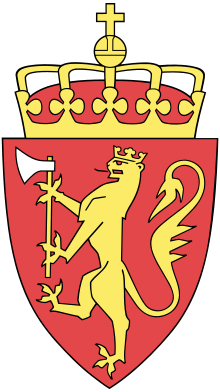Hemsedal
Hemsedal is a municipality in Viken county, Norway. It is part of the traditional region of Hallingdal. The administrative centre of the municipality is the village of Trøym. Hemsedal lies on the Norwegian National Road 52 (Rv 52). Hemsedal is located 220 km (136.70 mi) northwest of Oslo and 273 km (169.63 mi) from Bergen. In 1897, Hemsedal was separated from the municipality of Gol to become a municipality of its own.[3]
Hemsedal kommune | |
|---|---|
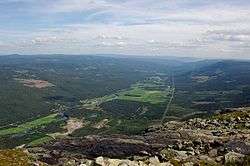 | |
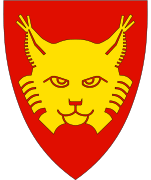 Coat of arms 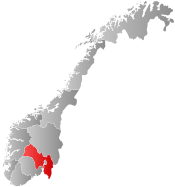 Viken within Norway | |
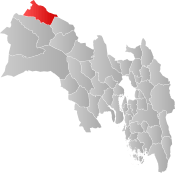 Hemsedal within Viken | |
| Coordinates: 60°54′21″N 8°30′53″E | |
| Country | Norway |
| County | Viken |
| District | Hallingdal |
| Administrative centre | Trøym |
| Government | |
| • Mayor (2003) | Oddvar Grøthe (Sp) |
| Area | |
| • Total | 753 km2 (291 sq mi) |
| • Land | 711 km2 (275 sq mi) |
| Area rank | 145 in Norway |
| Population (2004) | |
| • Total | 1,876 |
| • Rank | 341 in Norway |
| • Density | 3/km2 (8/sq mi) |
| • Change (10 years) | 13.2% |
| Demonym(s) | Hemsedøl[1] |
| Time zone | UTC+01:00 (CET) |
| • Summer (DST) | UTC+02:00 (CEST) |
| ISO 3166 code | NO-3042 |
| Official language form | Nynorsk[2] |
| Website | www |
General information
Name
The Old Norse form of the name was Hemsudalr. The second element is dalr, which means "dale" or "valley"; the first element is usually taken as the genitive case of the river name Hemsa (now Hemsil) of unknown derivation, although Sophus Bugge believed that it might derive from the Old Norse hemsa, hefnsa or hofn, meaning "going to pasture". The Norwegian word hems ("bed built in a small loft room") is named after the valley of Hemsedal.[4]
Coat-of-arms
The coat-of-arms is from modern times. The arms were granted on 2 October 1992 and were designed by Stein Davidsen. The arms show a gold lynx head on a red background.[5]
| Ancestry | Number |
|---|---|
| 130 | |
| 126 | |
| 65 |
History
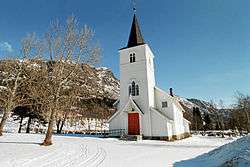
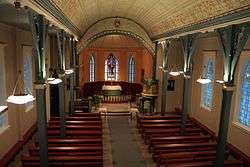
Early history
Hemsedal stave church (Hemsedal stavkyrkje) is believed to have been built between 1207 and 1224, and is first mentioned, as Ecclesia Aamsodal, in the accounts and diaries of the Papal nuncios sent to Scandinavia to collect tithes in 1282–1324.[7] In 1327 it was also mentioned under the name Skodvinar Kirkja i Hemsudali; this refers to alternate names of the farm where it stood, Kyrkjebøen: Skodvin and Skadengård. The church was dismantled in 1882.[8]
Hemsedal Church (Hemsedal kyrkje) was built during 1882 as a replacement for Hemsedal stave church. It was constructed of wood on the basis of plans by architect Johannes Henrik Nissen. It has 500 seats. The organ was built in 1888 by Olsen & Jørgensens orgelfabrikk and was restored in 1976. The church is associated with the Hallingdal deanery of the Diocese of Tunsberg.[9]
The valley has traditionally had small and medium-sized farms that were widely scattered on the valley bottom on both sides of the river and along the slopes. Because of the high altitude, farming has concentrated for the most part on livestock and dairy, and use of summer shielings has been important for the farms, which could not find sufficient pasturage in the valley bottom. Most therefore had milking stations on the shielings.
In the 1647 cadastre there was only one farm in Hemsedal large enough to pay full taxes; there were 24 liable for half taxation and 15–16 assessed as disused. In addition, there were a number of enterprises that were not assessed tax. The estimated population was about 400 (the exact number is unknown). Until the mid-19th century, the population increased steadily. In 1845 there were 1,775 people in the village. However, the population declined again over the next 75 years. In 1920 it had fallen to 1,358, before once more starting to increase. [10]
Recent history
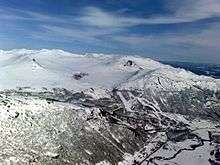
Skogstad Hotell was completed in 1905 as the first hotel in the village. Before that, in the latter half of the 19th century, a road had been built through the village with the hope that it would become a major route to Western Norway. However, things changed dramatically with the opening of the Bergen Railway in 1909. Hemsedal once more became a detour, while upper Hallingdal took over as the main route.[11]
After the World War II, new places to stay were established in the valley, such as Vangen Pensjonat (inn) at Tuv (1947) and Lykkjaheim Pensjonat (1953). A tourist agency was established in 1939 and in 1952 suggested building a ski lift in Hemsedal, but this did not happen until 1959, when Fossheim Pensjonat created the Tottenheisen, a 350-metre (1,150 ft) ski lift behind the inn at Ulsåk, serving the first piste in the village, Tottenløypa. However, this lift was torn down in 1961.[12][13]
Hemsedal Skisenter opened at Holdeskaret in 1961, and a few years later, planning began for tourist development. Over the five years beginning in 1980, a series of new businesses aimed at tourists were established. The first chairlift, Olaheisen, opened in 1983. Tourism has continued to grow in economic significance for Hemsedal. More than half of visitors come from abroad. Hemsedal is now also popular in the summer season, due to opportunities for fishing, hiking, climbing, cycling, golf and other activities.[14][15]
Geography
The municipality is bordered to the north by Vang and Vestre Slidre (both in Oppland county), to the east by Nord-Aurdal (in Oppland county) and Gol, to the south by Ål and Hol, and to the west by Lærdal (in Sogn og Fjordane county). Lakes in the region include Juklevatnet.[16]
Economy
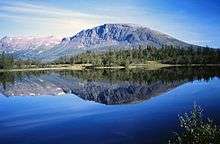
Hemsedal's economy has traditionally been is based on agriculture and is now increasingly driven by tourism.
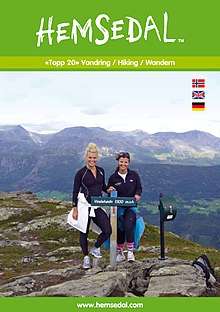
Tourism
One of the first tourists in Hemsedal was the Norwegian polar explorer Fritjof Nansen, who visited in 1898 and stayed at the Bjøberg Fjellstue. Today Hemsedal is a popular destination, with Hemsedal Skisenter the main attraction. About 70% of all visitors come in the winter season (December–May) and most of the remaining 30% in the summer months.[14]
Hemsedal Skisenter is the second largest ski resort in Norway. The ski centres in Hemsedal and Grøndalen were bought in 2000 by the Swedish company Sälenstjärnen, which changed its name the following year to Skistar. Skistar also owns Trysil Ski Centre, Sälen and Åre, Vemedalen and Hammarbybacken in Sweden.[17]
Øvre Løkji is a museum farm from which there are several trails up into the mountains. Hemsedal's cross-country stadium is located at Gravset and is the starting point for a large network of trails to Lykkja and Gol, including 10 km (6.21 mi) of lighted trails.[17]
Attractions
- Hemsedal Bygdetun is located at Øvre Løkji in the village of Ulsåk. The museum has houses and artifacts from the early 18th century.[18]
- Rjukandefossen waterfall is located in the vicinity of the village of Tuv[19]
- Hemsedal Top 20 offers mountain climbing during summer months.[20]
Notable residents
- Josef Monsrud (1922 - 2009) was a Norwegian forester and resistance member during World War II. At the age of twenty he joined the resistance Osvald Group. He went through some initial training and was hired as a guard for the strictly illegal Communist Party of Norway which had a secret base in Hemsedal.
- Kjell Venås (born in Hemsedal 1927) is a Norwegian philologist. He spent most of his career at the University of Oslo as a lecturer and as a professor (1971 to 1997), specializing in research about the Nynorsk language form
- Ingrid Wigernæs (born in Hemsedal 1928) is a retired Norwegian cross country skier who won a silver medal in the 3×5 km relay at the 1966 World Championships
- Sigrun Slapgard (born in Hemsedal 1953) a Norwegian journalist and non-fiction writer
- Erik Wøllo (born in Hemsedal 1961) is a Norwegian composer and musician, guitarist and synthesist. As a solo recording artist, he is most known for his electronic and ambient musical soundscapes
- Hege Nerland (1966–2007) was a Norwegian politician for the Socialist Left Party. In 2003 she helped found the local party chapter in her native Hemsedal.
- Geir Skeie (born 1980) is a Norwegian chef and restaurateur, who worked at the Skarsnuten Hotel in Hemsedal
- Eirik Markegård (born in Hemsedal 1984) is a Norwegian footballer who plays as a striker for the Norwegian fifth Division side Jardar
- Erik Solbakken (born in Hemsedal 1984) is a Norwegian television presenter. Solbakken was one of the hosts of the Eurovision Song Contest 2010
Sister cities
The following cities are twinned with Hemsedal:[21]
|
Gallery
- Hemsedal Community Office
- Hemsedal Library
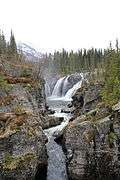 Rjukandefoss
Rjukandefoss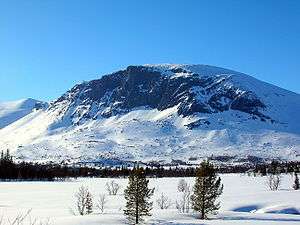 Skogshorn in winter
Skogshorn in winter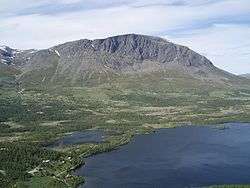 Skogshorn in Summer
Skogshorn in Summer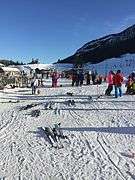 Hemsedal Skicenter
Hemsedal Skicenter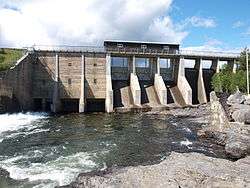 Tisleifjorden Dam
Tisleifjorden Dam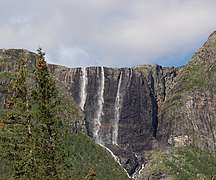 Hydnefossen
Hydnefossen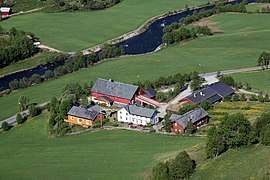 Fausko Skysstasjon
Fausko Skysstasjon
See also
References
- "Navn på steder og personer: Innbyggjarnamn" (in Norwegian). Språkrådet.
- "Forskrift om målvedtak i kommunar og fylkeskommunar" (in Norwegian). Lovdata.no.
- Geir Thorsnæs. "Hemsedal". Store norske leksikon. Retrieved 15 September 2016.
- Haugen, Einar (1967) Norwegian-English Dictionary A Pronouncing and Translating Dictionary of Modern Norwegian (University of Wisconsin Press) ISBN 978-0-299-03874-8
- "Kommunevåpenet" (in Norwegian). Hemsedal kommune. Archived from the original on 22 December 2008. Retrieved 7 January 2009.
- "Immigrants and Norwegian-born to immigrant parents, by immigration category, country background and percentages of the population". ssb.no. Archived from the original on 15 July 2017. Retrieved 29 June 2015.
- P. A. Munch, ed., Pavelige Nuntiers [J. de Serone, B. de Ortolis, P. Gervasii] Regnskabs-og Dagböger, førte under Tiende-Opkrævningen i Norden 1282–1334, Christiania: 1864, OCLC 562932132 (in Danish)
- Håkon Christie. "Hemsedal stavkirke". Stavkirke.info. Retrieved 15 September 2016.
- Sigrid Marie Christie, Håkon Christie. "Hemsedal kirke". Norges kirker. Retrieved 15 September 2016.
- Municipal fact sheet from Statistics Norway
- "Skogstad Hotell". Destination Hemsedal. Retrieved 1 October 2017.
- "Vangen Pensjonat på Tuv i Hemsedal". digitaltmuseum.no. Retrieved 1 October 2017.
- "Lykkjaheim Pensjonat og Kafé i Lykkja i Hemsedal". omnia.ie. Retrieved 1 October 2017.
- "Hemsedal facts", Storelia.no
- "Hemsedal Skisenter". hemsedal.com. Retrieved 1 October 2017.
- "Juklevatnet". aroundguides.com. Retrieved 1 October 2017.
- "Archived copy". Archived from the original on 24 July 2011. Retrieved 28 January 2011.CS1 maint: archived copy as title (link)
- "Hemsedal Bygdatun". Hallingdal Museum. Retrieved 1 October 2017.
- "Rjukandefossen". Destination Hemsedal. Retrieved 1 October 2017.
- "Hemsedal Topp 20 hiking". Destination Hemsedal. Retrieved 1 October 2017.
- "Venskapskommunar" (in Norwegian). Hemsedal kommune. Archived from the original (Microsoft Word) on 24 July 2011. Retrieved 7 January 2009.
| Wikimedia Commons has media related to Hemsedal. |
External links
| Look up Hemsedal in Wiktionary, the free dictionary. |
![]()
![]()
